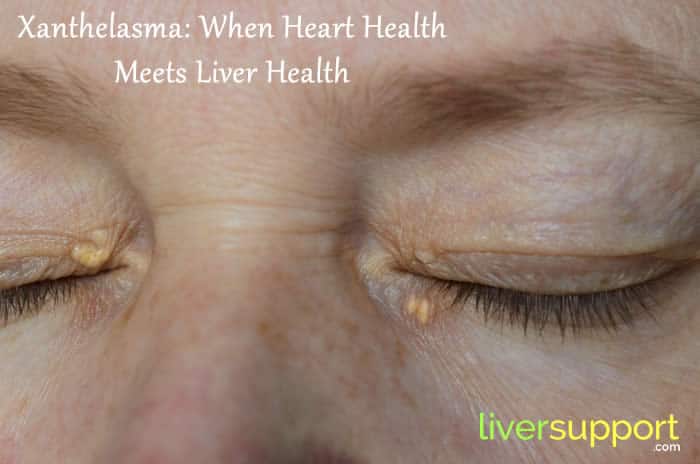
Previous
New Therapy for Primary Biliary Cholangitis Patients

Next
Boost Your Liver's Health with a Post-Winter Detox
Xanthelasma: When Heart Health Meets Liver Health
Xanthelasma is a condition that can be related to heart health and liver health. Discover the connection!
Though heart health and liver health are generally two fairly separate topics, there are instances when one can impact the other, sometimes in a not-so-healthy way. One of those instances is a condition called xanthelasma.
What is Xanthelasma?
In xanthelasma, cholesterol deposits build up under the skin around the eyes, generally on or near the eyelids. These deposits can be flat or elevated and are yellow in color.
Research published in early 2018 by the Journal of Cutaneous and Aesthetic Surgery indicates that xanthelasma affects an estimated 4% of people and is more common in women than in men (1.1% versus 0.3%, respectively). (1) Additionally, while it can appear in both younger and older individuals, it is generally most prominent in 40 and 50-year-olds.
This research further indicates that, in three out of four cases, the high cholesterol—also referred to as hyperlipidemia—that causes xanthelasma is hereditary. It is passed down from the parents. In the other 25% of the cases, this cholesterol buildup has other causes, such as those related to diabetes, hypothyroidism, or obesity.
The American Academy of Ophthalmology (AAO) adds that xanthelasma can be an early sign of heart disease. (2)
But what does any of this have to do with liver health?
Xanthelasma and Liver Health
In addition to having high blood cholesterol, the risk factors for xanthelasma include:
- smoking
- being overweight
- and having high blood pressure. (2)
What other condition has these same risk factors? Non-alcoholic fatty liver disease or NAFLD.
In May of 2021, the Journal of Inflammation Research published a study in which researchers sought to determine if there was, in fact, a connection between these two conditions. This study looked at 37 patients with xanthelasma and used their health information to determine if they were also at risk of NAFLD. Based on their findings, the answer was yes. (3)
The study subjects, all of whom had been diagnosed with xanthelasma, had higher hepatic steatosis and ZJU index scores. Hepatic steatosis refers to extra fat in the liver, or fatty liver disease. The ZJU index is a model used to predict non-alcoholic fatty liver disease within a Chinese population.
Other factors that connected xanthelasma with an increased risk of liver disease included the patients having higher lipid parameters, higher total cholesterol serum levels, and higher fasting glucose levels.
Several health experts have reaffirmed the connection between the two health conditions, with some even referring to xanthelasma as, in part, “an ocular manifestation of liver disease.” (4)
If You Have Cholesterol Deposits Around Your Eyes
If you notice yellow patches around your eyes, whether raised or not, it is recommended that you make an appointment with your doctor. This healthcare professional can help determine if these patches are, in fact, cholesterol or lipid deposits due to xanthelasma.
Should xanthelasma be confirmed, these deposits can be removed via:
- chemical peel
- cryotherapy
- laser
- or surgery. (5)
Though, it’s also important to consider their cause. One way to see if they are connected to your liver health is to look at your liver function to determine if there is a link.
Preventing Xanthelasma
Fortunately, there are a few actions you can take to help prevent xanthelasma, thus improving both heart and liver health.

These include:
- limiting the amount of saturated fat in your diet
- exercising regularly
- quitting smoking
- and drinking alcohol in moderation. (2)
Doing these four things can help your heart and your liver function more effectively and more efficiently. That makes this one heart and liver connection worth celebrating!
(1) Laftah, Z., Al-Niaimi, F. (2018, January – March). Xanthelasma: An Update on Treatment Modalities. Journal of Cutaneous and Aesthetic Surgery. doi:10.4103/JCAS.JCAS_56_17
(2) American Academy of Ophthalmology. (2021, May 12). What Is Xanthelasma? Retrieved January 15, 2022, from https://www.aao.org/eye-health/diseases/what-is-xanthelasma
(3) Chen, H., Lin, J., Wu, Y., Chiu, Y. (2021, May 12). Risk of Non-Alcoholic Fatty Liver Disease in Xanthelasma Palpebrarum. Journal of Inflammation Research. doi:10.2147/JIR.S305694
(4) Tooley, A., Sweetser, S. (2016, June 28). Clinical Examination: Eyes. Clinical Liver Disease. doi:10.1002/cld.561
(5) American Osteopathic College of Dermatology. (n.d.). Xanthelasma. Retrieved January 15, 2022, from https://www.aocd.org/page/Xanthelasma






